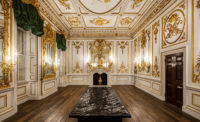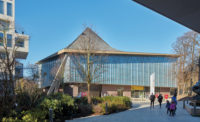2016 London Design Festival
The 14th annual festival takes over England’s capital, offering a bounty of ideas and visual treats.

Alison Brooks Architects’ The Smile served as a study in the material possibilities of cross-laminated American tulipwood.
Photo © Alison Brooks Architects

Foil, by Benjamin Hubert, cast flecks of light around the Tapestry Room at the Victoria & Albert Museum.
Photo © Nathan Ceddia

Bompas & Parr’s garden, L’Eden, used sensors and mechanics to physically respond to visitors’ movements.
Photo © Benjamin Hubert/Braun

Eley Kishimoto applied its Flash pattern to several crosswalks in the duo’s Brixton neighborhood, aiming for the change to reawaken traffic awareness and improve safety.
Photo © Eley Kishimoto




For nine days in September, when the London Design Festival’s distinctive red signage appears at scores of event locations, the remarkable breadth of the U.K.’s design industry is made visible. The 14th edition, held September 17 to 25, was a sprawling affair: hundreds of designers and manufacturers hosted events across the city, while five separate trade fairs ran concurrently.
Commissioned projects gave a sense of order to the dizzying array of pop-ups and partnerships, lectures and launches. At the Victoria & Albert Museum, the festival’s official hub, temporary large-scale exhibits were installed among the permanent displays. The Green Room, by London-based product designers Glithero, featured a cylindrical curtain of 160 brightly hued cords that dropped down through a six-story stairwell; individual strands gently rose and fell over the course of a minute, inviting viewers to reconsider what a clock could be. In the Tapestry Room on an upper floor, Benjamin Hubert’s wavelike Foil—an animated ribbon of 50,000 stainless-steel mirrors—scattered light across the walls like a giant disco ball.
At the nearby Chelsea College of Arts, another ambitious project occupied the courtyard. Alison Brooks Architects’ The Smile, a pavilion in the form of a curved box beam, demonstrated the construction capabilities of cross-laminated American tulipwood. While the center of the 112-foot-long arc rested on the ground, both of its ends rose 11 feet into the air, ending in large openings that offered those inside framed views of the college and the sky. (Unlike most of the festival’s installations, which ended on the 25th, The Smile was on view through October 12.)
Downriver to the east, Somerset House—a neoclassical cultural center and home to the Courtauld Institute of Art—hosted the inaugural London Design Biennale. For that, curatorial teams from design museums in 37 nations produced pavilions that responded to the theme of utopia, selected to mark the 500th anniversary of Thomas More’s classic work. Occupying a prominent spot in the center of the entrance courtyard was Barber Osgerby’s Forecast. The super-sized weathervane, anemometer, and wind turbine alluded to Britain’s maritime history, turbulent politics, and—of course—fabled obsession with the weather.
In Shoreditch, architect Asif Khan erected three small, enigmatic translucent polycarbonate structures, which he then stocked with furniture and thickets of plants. Called Forests, the project, commissioned by MINI Living, explored the potential of “third places” in the city: spaces to gather in the public realm, away from home and work. Khan, who designed a summerhouse for the 2016 Serpentine Pavilion program, explained that he hoped his interventions would raise questions about the relationship between public and private space as well as foster interactions among strangers.
Bompas & Parr also used vegetation as a material in L’Eden, a bio-responsive garden installed in a Soho gallery. The fairy-tale indoor landscape used concealed mechanics and motion detectors to animate living plants, having them react as visitors moved through the space. Thus, under a starlit LED curtain, tendrils drew themselves back to make a path, and a dancing tree swayed to mirror spectators’ motions.
Similar levels of ingenuity could be seen in designers’ showrooms. To introduce his new lighting range, Lee Broom, for example, transformed his East London store with an Op Art–inspired installation. Opticality featured geometric-patterned pendant fixtures endlessly multiplied by mirrored walls to create the illusion of infinite space.
Eley Kishimoto took this energy to the streets—literally. With graphic designer Dolman Bowles, the fashion duo applied its signature Flash pattern to crosswalks at busy intersections in Brixton, improving safety while adding some visual flair to the urban environment.
In all, the London Design Festival’s messy diversity is its strength: grand spectacles coexist happily with subtle interventions, and culture nestles with commerce. As the event expands into new territories and widens its international participation, its mix grows ever richer.






